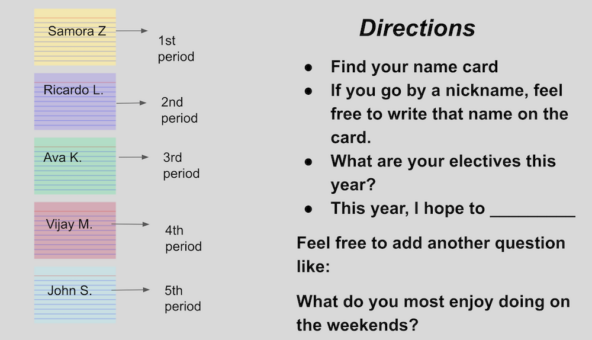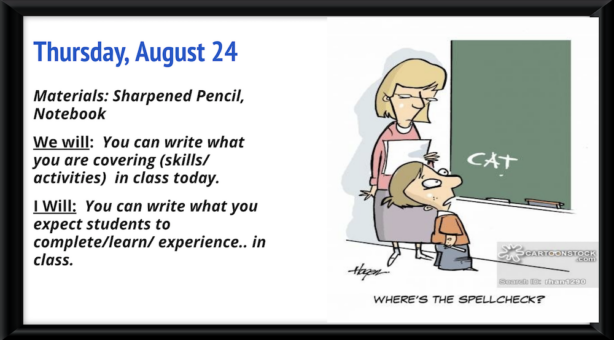Helping New Teachers Manage Their Students
How can seasoned educators improve the teacher retention rate? By helping new colleagues address two retention factors – student discipline and classroom climate – says middle grades veteran Sharon Ratliff. “Let’s show them how to manage their school of fish without being a shark.”
By Sharon Ratliff

As a seasoned teacher, I was thrilled to have a fresh pair of eyes and eager to watch Ms. Galloway in action. Statistics were not on my side regarding retaining teachers, and I was determined to provide Ms. Galloway with an authentic and engaging student-teaching experience.
“Do you need me to make anything for you?” Alice inquired, “What about a list of the classroom rules? Our professor told us it was important to have our rules posted.”
Pondering Alice’s question, I simply replied, “I have my one rule posted here. We will go over other procedures, but for now, this is what we need for the first day of class.”
After Alice read my rule, she replied, “I can see that one rule covers almost everything!”
Across the country, over 300,000 new teachers are beginning their careers, and sadly thirty percent of those teachers will leave education within five years. There are many factors (compensation, class sizes, policies, politics) impacting teacher retention that are out of our direct control. But two factors – student behavior and classroom climate – are areas where teachers do have a direct influence and where our mentoring of new colleagues can help increase their “survival rate.”
Over the past 25 years, I have had the opportunity to host many student interns and mentor many first and second-year teachers. I want to share some classroom management strategies that have enabled me to help them (and myself) swim and not sink.
Start-of-School Strategies to Keep You Afloat
► Seating Strategically – (It’s as easy as ABC)
Start with assigned seating. Take the guesswork out of the equation and have notecards or post-it notes with the students’ names (as written on the roster) at an assigned seat. I color-code these notecards and have students revise the card if they go by a different name.
In addition, have students answer a few questions on this card, then collect and keep them. When it’s time to rearrange seating (even at the beginning of a new grading period), simply redistribute the cards before class begins. Example
► Avoid Drowning Your Students
Remember, in middle school, students may have between four and seven teachers. Imagine flying to five destinations in one day on a different aircraft type with the flight attendant announcing the safety procedures on each flight. By the third flight, chances are pretty good you’re putting your earbuds in and tuning out the flight attendant reviewing emergency procedures.
While teaching routines and structures are essential, don’t drown your students with your expectations and procedures on the first day. Instead, explicitly teach the expectations throughout the week.
Consider having one overarching rule: “Respect yourself and everyone else in this room.” After introducing this rule, ask students, “What does respect look like?” To incorporate community while discussing this overarching rule, have students contribute what respect looks like in the classroom. Students write (or draw) what respect looks like, which is categorized in an affinity map.
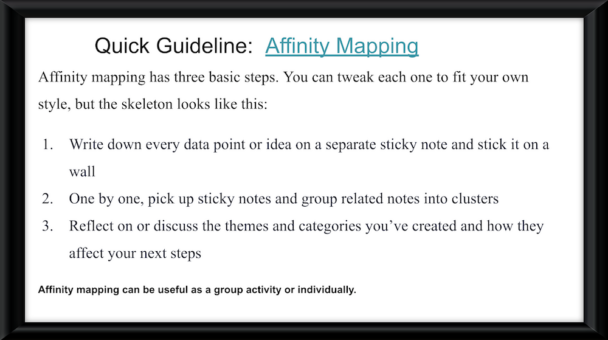
► Stay Away from Sedentary
Even at rest, fish keep their gills moving. After defining the overarching rule, get students involved in your class. An effective way to include movement involves using stations related to your content area. These ideas are for the language arts classroom, but you could adapt them for other content areas.
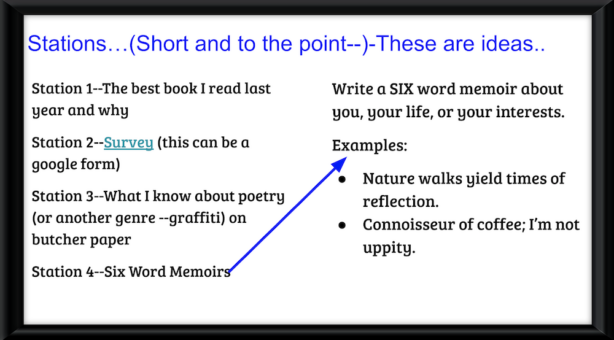
Navigational Tips During the First Weeks
It was seventh period, and we were ready to respond to a quick write when Matheson raised his hand and announced, “Miss, I don’t have a pencil.” (I banished my thoughts of how did Matheson make it to seventh period without a pencil?”) As my school of fish froze, they waited with an anticipatory look thinking, “How is Mrs. R going to react?” I knew this was the perfect time to discuss expectations regarding classroom supplies.
“Matheson, we have a procedure for when you forget a writing utensil,” I calmly replied. “Just borrow one of the pencils above the file cabinet and sign out for it. Be sure to return it at the end of class.” (Tip: Golf pencils are ideal for this minor issue. It’s incredible how students start showing up with pencils if you only have stumpy pencils for students to borrow.)
► Stop and Explain
The above scenario is the opportune time to teach students on the spot how to handle supply issues. For example, if you expect students to have a sharpened pencil for class, post the required materials on a slide or whiteboard.
Another stop-and-explain example would be how to turn in work. If students are turning in a paper assignment, describe the collection process. For online assignments, explain the submission process. I often have a student “drive” my computer to show the step-by-step process for submitting online.
► Student Agreements
To build a community, student agreements promote a positive environment and a sense of belonging. Have students, individually or in small groups, respond to prompts such as:
- How do you learn best?
- What interrupts your thinking?
- With group work, my classmates need to know ______
- ___________ is something that distracts me in the classroom….
Use the answers students give to compile an anchor chart of classroom agreements, and then have students autograph the agreement poster. Another alternative is to give small groups one question and have the group write a concise guideline for that answer. Then students can add (graffiti or use a post-it note) to add to answer. In the past, these guidelines have been referred to as “Classroom Contracts” or “Classroom Constitution”, but the important factor is students are included in forming the agreements which fosters group accountability.
► Be Friendly, but Not Their Friend
Alan Clifton, another new teacher, immediately established rapport with students. He was known for energetic presentations and treating his classroom like a stage. However, Mr. Clifton quickly went from an enthralling GOAT to a sinking boat. Why the sudden plunge into the abyss?
Unfortunately, Alan made the mistake of telling students too much information about his personal struggles. Alan thought he was building rapport by being their friend, but in reality, students viewed Alan as a peer and lost respect for him as a teacher. As teachers, we need to remember that our students are not our peers. Teachers are leaders, facilitators, and advocates. Treating students like peers will backfire. Even if you talk about sports, music, or video games with your students, you are not their peer. You are their teacher.
► Post the Goal
I always post the “We will/I will” statement on the slides or the board. Students need to know what the goals are for each day. Putting up a statement doesn’t signal a boring class; it signals student efficacy. “We will/I will” statements furnish a reflection opportunity at the end of class where students reflect and measure their perceived mastery.
► Plan – Plan – Plan
Think of all the professions which require planning: captains (float plan), pilots (flight plan), and doctors (surgical plan). These well-known professions also include alternate plans if obstacles appear. Flexibility is the invisible fishing line of effective planning.
As teachers, we should always have a plan that includes student engagement and options of what to do if students do not understand a concept or if students swiftly move through instruction. Specifically, if you have a class that ends 3-5 minutes early, avoid letting students line up at the door or being on devices. Instead, have bell ringers on hand. (Bell ringers also nurture a classroom community.)
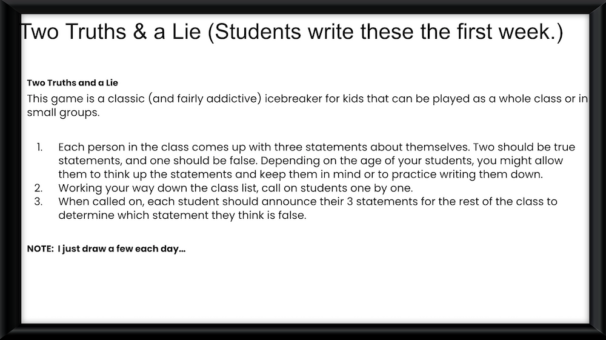
► Swimming Upstream
If a few of the fish in your pool start swimming in a different direction, stay level-headed. Ask these three questions privately to a student who is off task:
- What are you doing?
- What are you supposed to be doing?
- What are you going to do about it?
By asking these questions, you are interrupting the thought pattern of the student. Some students don’t realize they have been caught up in a different current or are drifting away from the activity or task. These questions redirect thinking.
► Address Off-task Behavior
Simply drop a “see me after class” card on the student desk. As middle school teachers, avoid singling students out in front of the class because misbehavior tends to escalate when teachers do this. Instead, talk to the student after class and document the off-task behavior. Follow your school’s discipline guidelines if a student is blatantly disrespectful.
► Give Brain Breaks
Ms. Galloway started teaching my fifth-period class the second week of school. She was doing an amazing job at planning and being prepared. However, we both noticed that fifth period seemed to lack enthusiasm.
“What am I doing wrong?” she inquired.
“Absolutely nothing Alice. We are witnessing the afternoon doldrums brought on by some students experiencing the sugar crash of lunch.” That’s when I introduced brain breaks to Alice.
Yes, you might think brain breaks are a waste of time. Still, research reveals, “regular brain breaks across the school day enhance students’ cognitive functioning and ability to sustain focus for academic work (Khan 2021). Sacrificing a few spare minutes to rejuvenate your school of fish is better than teaching listless jellyfish whose attention floats aimlessly through your class.

► Implement Your School’s Discipline Procedure
At the beginning of the year, the surf is choppy, and teachers often feel endless waves of information envelop their time. However, it is important to read the handbook and understand how your school handles discipline. By knowing the school policy on technology, types of discipline issues, and blatant misconduct, you will be more confident and have the administration’s support by following the correct protocol.
► Find an Experienced Ichthyologist (a mentor teacher)
If you are a new teacher and your school does not have a mentor program, seek an experienced educator to bounce ideas off of. If you are an experienced teacher, be available to new teachers looking for help.
If we are going to help reverse the growing exodus of teachers, it’s imperative that we encourage, support, and share classroom community tips. I have sought mentor teachers for myself throughout my professional life. Even if you teach for several years and then move to a new school or a new position, mentors help you stay afloat.
Our Goal Is a Smooth Sea
Teachers are not sharks; we are not out to trap students. However, we must be mindful of best practices that assure smooth seas. Remember, classroom climate is an area teachers can control. As you work with your school of fish this next year, take time to implement management techniques and build community with students. Ultimately, students will see that their learning matters, and you will reap the intangible rewards of teaching.
Note: While the names have been changed, the above scenarios are real-life examples.
Works Cited
Cain, Sean, and Mike Laird. The Fundamental 5: The Formula for Quality Instruction. CreateSpace Independent Publishing Platform, 2011. Accessed 19 June 2023.
Khan, Saniya. “What Are Brain Breaks? Why Is It Necessary For Students?” EdTechReview, 15 September 2021. Accessed 29 June 2023.
Jota, Jota. “10 Quiet Brain Breaks that Every Teacher Needs.” Señora Jota Jota, 4 August 2018. Accessed 19 June 2023.
Shelton, Caitlyn. “State by state: America’s teacher shortage.” NewsNation, 26 January 2023. Accessed 20 June 2023.
Welcome – Capturing Kids’ Hearts. Accessed 27 June 2023.
Sharon Ratliff (@sharondratliff) recently shifted from 7th grade ELA teacher to middle school gifted and talented facilitator in Katy, Texas. Before stepping into the mysterious land of middle school, Sharon taught upper elementary in Texas, Florida, and with the Department of Defense.
Over the past 20 years, Sharon has mentored young teachers, hoping to pass along a love for educating young minds. She enjoys working with all students, developing curricula that emphasizes critical thinking and discovering reading and writing techniques that empower students in real-life applications.
Feature image by PublicDomainPictures from Pixabay

